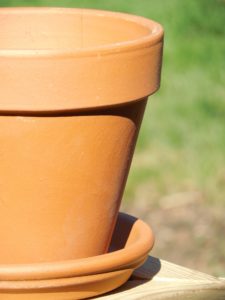It’s no secret; I love my citrus trees. Growing lemon trees on my windowsill was one of the best experiments I’ve ever tried; I didn’t think growing citrus indoors would work, but I’m glad to report I was wrong! Today, I’ve gone from that little lemon tree with its one fat lemon to a whole row of potted citrus trees on my windowsill – limes, oranges, tangerines and more – and it all started with a lemon I bought for myself as a birthday present.
This blog is another entry in a series of articles on how to care for indoor lemon trees and keep them not just alive but thriving, even in northern-zone winters. This article focuses on keeping the roots of your potted lemon tree happy with the right size (and color!) pot and the right amount of moisture for your windowsill tree to thrive. Enjoy!
**NOTE: This post contains excerpts from my book, The Complete Mini-Guide to Growing Windowsill Lemon Trees: A Reference Manual for Northern-Zone Gardeners. The book is a comprehensive instruction manual for growing potted lemon trees indoors, and may be purchased on Amazon in ebook or paperback formats for less than the price of a fancy cup of coffee!**
CHOOSING THE CORRECT POT FOR WINDOWSILL LEMON TREES

Yes, the size of your pot matters. This isn’t just for your tree’s health – it’s for yours! If you are moving that tree in and out of your house every spring and fall, you have to consider what you are capable of moving, whether you’ll have help, and whether you’re still going to be physically able to move that tree for another decade or however long it may live. Consider wheeled pots or wheeled bases for your pots, investing in a wagon that eliminates the need to haul that pot up from ground-level twice a year, or using an ugly bucket with a sturdy handle instead of a lovely decorative pot that weighs an additional 15 pounds and has no hand-holds.
Oddly enough, the color of your pot matters too. A black pot is a heat-sink, and in sunny summer weather – even in cold zones – the direct sun can overheat the soil. If your soil is overly moist, this can rot out the roots. Even if your soil is dry, the heat can damage or destroy the root ball, particularly for root-bound trees with a significant portion of roots pressed against the wall of the pot. You can get away with a black pot if you tend to have moderately warm summers or partial shade throughout the day, but it’s something to be aware of during hot, sunny weather. Lighter-colored pots are a better choice for long-term health of the tree.
Don’t forget an overflow saucer to go along with your pot. The saucer should be relatively deep to allow for full drainage, but if possible, choose one with a supporting structure across the bottom that holds the pot up out of the drainage water. If there is no crosshatch or other supports in the bottom of the dish to keep the pot from sitting directly in that water, you should consider tipping out the saucer after you water the tree. Lemon trees are best suited to semi-arid regions, and standing water around their roots is completely alien to their biological programming. When you water the tree, wait a few hours for it to completely drain, and then help the tree out by either tipping out the saucer or using a suction squeezer like a turkey baster to remove most of the water from the dish. In a real pinch, you can drop a hand towel into the saucer; it will soak up the extra water (and probably will stain, so heads up). Either emptying out the saucer regularly or choosing a saucer with a support structure will keep your pot out of standing water, help avoid getting your dirt spongy and rotting out the root system.

You also need to consider root growth before you repot your tree. A smaller pot means the roots are constricted – which, depending on your space needs, is not always a bad thing with a windowsill tree. Pruning will always be necessary for shape and health, but a smaller pot will assist you in naturally restraining the growth of the tree. Please don’t take this to extremes and try to grow a lemon tree in a teapot, but do take the size of the tree into consideration before you buy a massive pot. (Make sure you select a dwarf lemon tree variety suitable for potted growing.)
When you do repot your tree into a larger container, make sure you don’t give it too much to handle all at once. A large pot for a tiny tree can be just as devastating as dropping that tree in the lawn to fend for itself. The problem is that tiny little roots can’t grow fast enough to handle all the moisture retained in a huge pot of dirt. Excessive moisture plus summer heat plus no inhibiting factors of other weeds (you DO keep weeds out of your plant pots, don’t you?) creates the perfect environment for your tree to rot out from the bottom up, rather than to encourage growth. Let some healthy root development take place before repotting, and then increase the pot size a little at a time.
WINDOWSILL LEMON TREES: AVOIDING OVERWATERING

Don’t overwater. I repeat: don’t overwater! The lemon is not a swamp-loving tree. Particularly in the winter, when container-grown lemon trees are indoors and hopefully at least semi-dormant, overwatering is far worse than underwatering. Your home’s humidity will have an impact on how often you need to water, but my trees have always gotten through their dormant season just fine with once-per-week watering. To gauge the need for more moisture, keep an eye on the soil around the base of the tree, and let it get dry to the touch before you add any additional water. Don’t trickle in a small amount of water every day; when you do water, give it enough to reach all the roots, and then let the tree fully absorb this before you come back with more. Those roots can’t tolerate constant damp, especially when they are dormant. Drainage is a really big deal. (Keep in mind that temperature and humidity needs for indoor lemon trees are interrelated!)
Another reason to avoid overwatering is to make your fertilizer last longer. Every time you water, nutrients drain right out with the excess water, reducing the fertility of your soil a little bit each time. You can help ameliorate this nutrient loss by pouring off the excess drainage water back into your watering can and saving it for next week’s watering, but if you don’t cap the can, this water may evaporate and leave you with a crusty residue that is an epic pain to clean away. The best solution is to just avoid watering too often.
Lastly but CERTAINLY not least, you need to be super careful about watering windowsill lemon trees, especially in winter. Believe it or not, less is more. When the plant starts to slide into dormancy, water causes problems because a) frigid water can mess with soil temperature and rot out the roots for a heat-loving plant, and b) overly warm water can either confuse the heck out of the plant (cold air + warm roots = very bad) or wake it out of dormancy entirely, which messes with internal systems and leaves the plant trying to put out new growth and run full-steam ahead during a cold, light-deprived winter season. I have a hard enough time trying to get my plants to survive zone 4 while dormant — I can’t imagine how it could get through the winter if it wasn’t snoozing.

This article is just a short rundown of a few selected care needs for your potted windowsill lemon tree, but for the total beginner – like I was when I bought my first tree! – some of these do’s and don’ts for your tree are absolutely critical to its health. If you are going to grow citrus in containers, you have to remember that their environment matters so much more than an outdoor grown tree, simply because it is artificial. Windowsill lemon trees can’t pull extra nutrients from deep in the soil, or extra water from the rain, or more heat from the sun. A container-grown lemon tree doesn’t have anything else to rely on but you, so be a good gardener and help them out a bit.
Interested in learning more about growing potted lemon trees indoors? Check out my book The Complete Mini-Guide to Growing Windowsill Lemon Trees: A Reference Manual for Northern-Zone Gardeners (available on Amazon along with its companion book The Complete Mini-Guide to Growing Windowsill Pomegranate Trees!) or read more excerpts here: